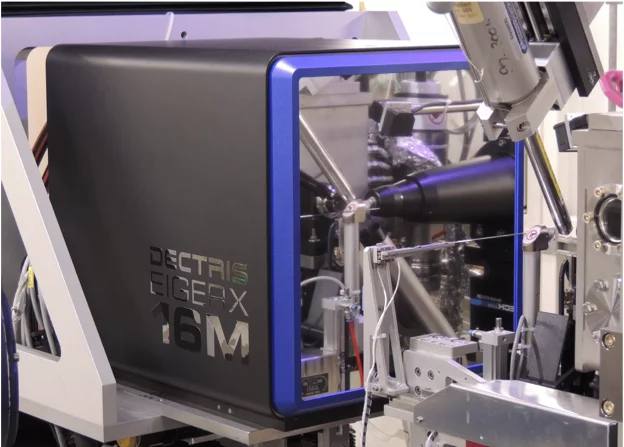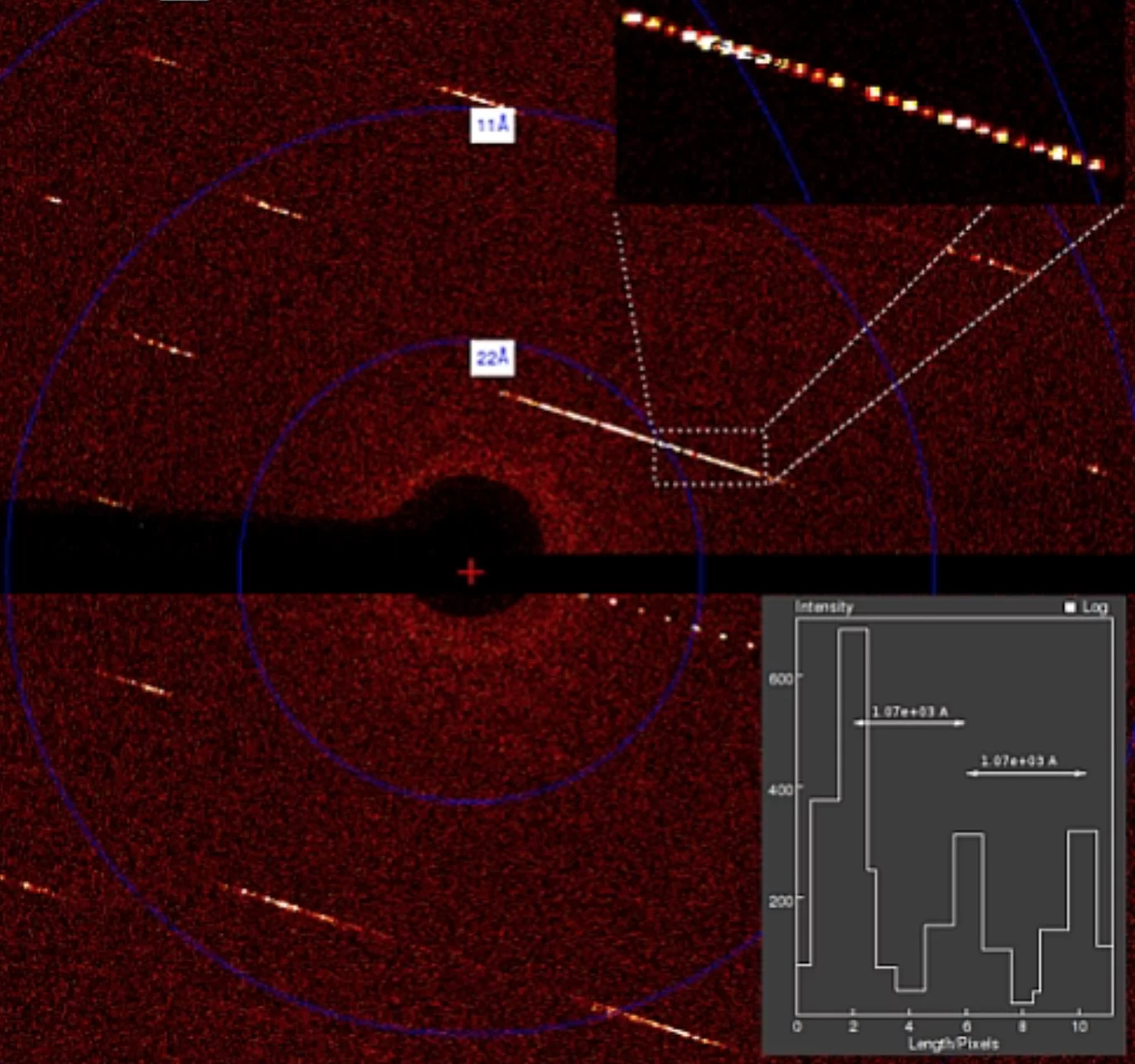The macromolecular crystallography beamline X06SA at the Swiss Light Source, a synchrotron operated by Paul Scherrer Institute, is the first one in the world to upgrade its detector to an EIGER X 16M.
The macromolecular crystallography beamline X06SA at the Swiss Light Source (SLS), a synchrotron operated by Paul Scherrer Institute (PSI), is the first one in the world to upgrade its detector to an EIGER X 16M. On 14 Oct 2015, the new detector entered service, and it is already a success. Meitian Wang, group leader and beamline responsible, is delighted with the new detector's stability. "Since its installation last month, the EIGER has operated without any problems", he said.
The EIGER X 16M succeeds a PILATUS 6M, an instrument that has led to the determination of many important protein structures and contributed to the reputation of beamline X06SA as one of the world's best. In addition to the technical specs, Wang is also excited about is the application programming interface that simplifies detector operation. The transition from the camserver of the PILATUS to the new API was a happy one.
Firmware version 1.5 delivered with the EIGER represents a very stable and high-performance release. "The system installed at SLS exceeds the specifications that we promised during the Synchrotron Radiation Instrumentation conference in July 2015", said Clemens Schulze-Briese, CSO of DECTRIS.
The EIGER X 16M succeeds a PILATUS 6M, an instrument that has led to the determination of many important protein structures and contributed to the reputation of beamline X06SA as one of the world's best. In addition to the technical specs, Wang is also excited about is the application programming interface that simplifies detector operation. The transition from the camserver of the PILATUS to the new API was a happy one.
Firmware version 1.5 delivered with the EIGER represents a very stable and high-performance release. "The system installed at SLS exceeds the specifications that we promised during the Synchrotron Radiation Instrumentation conference in July 2015", said Clemens Schulze-Briese, CSO of DECTRIS.
In tests before the EIGER went online, Wang and colleagues collected data from crystals whose longest unit cell dimension exceeded 1000 Å. Thanks to EIGER's pixel size of only (75 µm)2, data could be collected to a resolution of 2.3 Å. More relevant for regular users will be the continuous read-out feature, which ensures duty cycles of above 99% even when the detector runs at full speed and makes breathtakingly fast experiments possible. In separate tests, Wang was able to successfully collect an entire S-SAD dataset within one second.
Among the first users of the EIGER X 16M was Hauke Hillen, a PhD student from the Max Planck Institute for Biophysical Chemistry in Göttingen. On a recent afternoon, he was busy collecting data for experimental phasing of a crystal structure based on the sulfur signal. Between datasets, he stopped for a quick chat: "I'm very impressed with the EIGER", he said. "It's so fast." With this, the conversation was over, as he had to rush back to his experiment.
The high frame rate and large number of pixels of the EIGER X 16M lead to unprecedented amounts of raw data. To make online data processing, speedy transfer to the users' home labs and reliable archiving possible, bit-shuffle filtered LZ4 compression was introduced. This compression strategy is not only fast enough to keep up with the generated data but also more efficient than CBF compression. Vincent Olieric, beamline scientist at the PSI, was impressed that the new detector does not generate much more data on disk than the previous PILATUS 6M. "It's great for users", he said.
The development of the EIGER X 16M now operating at SLS was accelerated by a grant by the Swiss Commission for Technology and Innovation (CTI) to promote collaboration between academia and business. The detector could thus be tested under realistic experimental conditions from an early stage. Moving from prototype to final product, DECTRIS engineers and scientists have developed an instrument that meets the needs of the most exacting X-ray crystallographers. Eventually, all EIGER customers will benefit from that.
Among the first users of the EIGER X 16M was Hauke Hillen, a PhD student from the Max Planck Institute for Biophysical Chemistry in Göttingen. On a recent afternoon, he was busy collecting data for experimental phasing of a crystal structure based on the sulfur signal. Between datasets, he stopped for a quick chat: "I'm very impressed with the EIGER", he said. "It's so fast." With this, the conversation was over, as he had to rush back to his experiment.
The high frame rate and large number of pixels of the EIGER X 16M lead to unprecedented amounts of raw data. To make online data processing, speedy transfer to the users' home labs and reliable archiving possible, bit-shuffle filtered LZ4 compression was introduced. This compression strategy is not only fast enough to keep up with the generated data but also more efficient than CBF compression. Vincent Olieric, beamline scientist at the PSI, was impressed that the new detector does not generate much more data on disk than the previous PILATUS 6M. "It's great for users", he said.
The development of the EIGER X 16M now operating at SLS was accelerated by a grant by the Swiss Commission for Technology and Innovation (CTI) to promote collaboration between academia and business. The detector could thus be tested under realistic experimental conditions from an early stage. Moving from prototype to final product, DECTRIS engineers and scientists have developed an instrument that meets the needs of the most exacting X-ray crystallographers. Eventually, all EIGER customers will benefit from that.
About DECTRIS Ltd.
DECTRIS Ltd. is the technologically leading company in Hybrid Photon Counting X-ray detection. DECTRIS Hybrid Photon Counting detectors have transformed basic research at synchrotron light sources, as well as in the laboratory and with industrial X-ray applications. DECTRIS aims to continuously improve the measurement quality, thereby enabling new scientific findings. A broad range of products is based on this pioneering technology; all scaled to meet the needs of various applications. DECTRIS also develops bespoke solutions for scientific and industrial X-ray detection.
https://www.dectris.com/
About PSI
The Paul Scherrer Institute (PSI) develops, builds and operates large, complex research facilities and makes them available to the Swiss and international research community. The institute's own key research priorities are in the fields of matter and materials, energy and environment and human health. PSI is committed to the training of future generations. Therefore about one quarter of the staff are post-docs, post-graduates or apprentices. Altogether PSI employs 1900 people, thus being the largest research institute in Switzerland. The annual budget amounts to approximately CHF 350 million.
Contact
Dr. Meitian Wang, Swiss Light SourcePaul Scherrer Institut, 5232 Villigen PSI, Switzerland
Phone: +41 56 310 4175, e-mail: meitian.wang@psi.ch
Dr. Stefan Brandstetter, DECTRIS Ltd.
Taefernweg 1, 5405 Baden-Daettwil, Switzerland
Phone: +41 56 500 2100, e-mail: stefan.brandstetter@dectris.com

